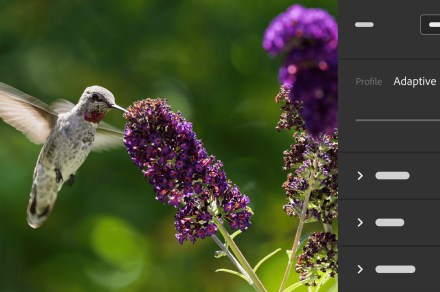Adobe
Adobe announced at its Max Japan 2025 design conference a pair of new AI editing tools for its Lightroom and Camera Raw applications designed to reduce the tedious repetition of many common tasks.
First off, Adaptive Profiles, which technically debuted last fall, is now generally available in both Lightroom and Camera Raw for color and monochrome HDR images. Per Adobe, Adaptive Profiles, “dynamically adjust the tones and colors of your photos, creating an enhanced, yet realistic, starting point for further editing.” But rather than apply the same pre-set enhancements to every image it is applied to, Adaptive Profiles uses AI to analyze each image and optimize its adjustments including Exposure, Shadows, Highlights, Color Mixer, and Curves.
Distraction Removal, on the other hand, is currently available in Early Access for Camera Raw users but is coming soon to Lightroom. It detects and removes distracting elements within an image photo, such as reflections in windows, crowds, or people photobombing in the background.
Adobe is also rolling out a new feature that is sure to save photographers time, effort, and potentially their sanity. The new Find Duplicates feature has arrived in Early Access for Lightroom on the web users that tracks down and removes duplicate images within its library so that users don’t inadvertently start editing the wrong shot. Find Duplicates is being bundled under the Clean Up tool, which can also find and remove blurred images and screenshots.
You’ll soon find it easier to share the photos you take through Lightroom mobile for iOS, thanks to a few new updates that are being released. The app, for example, will now auto-generate shareable links that you can be viewed by anyone you send them to, regardless of if they have Lightroom themselves. That link generation process will also be 75% faster than before. You’ll be able to quickly designate how and where your images will be shared — whether that’s copying the link, sharing over social media, or sending them directly
to your contacts. There’s no word yet on when these sharing features will arrive on the Google and Samsung Lightroom apps.
Andrew Tarantola is a journalist with more than a decade reporting on emerging technologies ranging from robotics and machine…
I tried out Google’s latest AI tool that generates images in a fun, new way
Google’s latest AI tool helps you automate image generation even further. The tool is called Whisk, and it’s based on Google’s latest Imagen 3 image generation model. Rather than relying solely on text prompts, Whisk helps you create your desired images using other images as the base prompt.
Whisk is currently in an experimental phase, but once set up it’s fairly easy to navigate. Google detailed in a blog post introducing Whisk that it is intended for “rapid visual exploration, not pixel-perfect edits.”
Read more
Google’s new Gemini 2.0 AI model is about to be everywhere
Less than a year after debuting Gemini 1.5, Google’s DeepMind division was back Wednesday to reveal the AI’s next-generation model, Gemini 2.0. The new model offers native image and audio output, and “will enable us to build new AI agents that bring us closer to our vision of a universal assistant,” the company wrote in its announcement blog post.
As of Wednesday, Gemini 2.0 is available at all subscription tiers, including free. As Google’s new flagship AI model, you can expect to see it begin powering AI features across the company’s ecosystem in the coming months. As with OpenAI’s o1 model, the initial release of Gemini 2.0 is not the company’s full-fledged version, but rather a smaller, less capable “experimental preview” iteration that will be upgraded in Google Gemini in the coming months.
Read more
Get ready for AI-dubbed YouTube videos
YouTube has reportedly started rolling out a new AI-empowered translation feature for its content creators, one that will automatically redub a video’s contents into one of nine languages without changing the speaker’s voice.
According to a post from X user @levelsio, “YouTube will now auto dub videos in English, Spanish, Portuguese, German, French, Italian, Hindi, Indonesian and Japanese” and “will use AI to take the original voice but change the language.”
Read more





GIPHY App Key not set. Please check settings